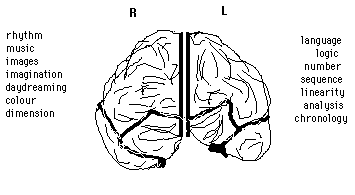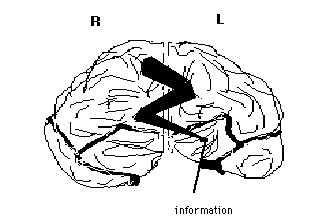
Creativity and The brain
Within the past 15 years people have come to know more about the brain than in all years before: finally the human brain is studying itself > this means growth.
It has for instance become common knowledge that the left and right hemisphere of the brain dominantly deal with different intellectual functions. The left brain primarily handles: logic, language, numbers, sequence, analysis, chronology, and so on, while the right brain deals with rhythm, colour, imagination, intuition, feeling, day dreaming, spatial relationships, and so on.

Recent research by Sperry, his student Ornstein, and presently Zaidel has shown that the left brain is not the so-called intellectual side, nor is the right brain the so-called intuitive, emotional side (something already explicitly stated by C.G. Jung). Both sides need to be used in conjunction for both academic and creative success.
The Right brain controls the left side and the Left brain controls the right side. The one cannot very well control both sides: there has to be balance even physically, hence either side must be controlled. This is called cooperative opposition.
If only one side is used: everything "is logical, rational", the wrong formula is used (Tony Buzan). De Bono calls this the Myth of the Monohop.
The brain is self-creating, the more it is used the more it can do, however, this should always be done in conjunction of the two brainhalves.
An example from your personal experience.
The scientific method starts in early childhood at school. Children are told to do something and if they cannot perform satisfactorily, they are told they are not doing well. This fact is corroborated when the child compares its work with that of others and thus is convinced it is no good at..... (whatever it was doing). The children are told to do it by themselves and not to cheat (look at the other children's work). So authority in the person of the teacher has established the fact that it is no good at ...... So many grown-ups have this idea that they are no good at: mathematics, drawing, music or ........ .
Our brain is perfect, but we are not always (??!) using it perfectly. When we have the formula that we are no good at ......, the brain will perform worse and worse in this area; we are bound to see the evidence because of our failures. And failures are bad: our culture rewards success and punishes failure. So we are trained in the schools to avoid failure, yet to make mistakes, i.e. to fail, is necessary to learn.
The 6 months' old child has no such fear and when given a toy it will have most interest in the wrapping: it will tear at the paper (tensile strength test), put it into its mouth (biochemical laboratory), spit it out (quality control reject= unfit for food), bang it on the table (try out the possibility for producing sound), etc. . The child is using its complete brain and is not hindered by any stereotyping. Stereotypes such as intuitive > female, rational > male. It is not afraid to make mistakes; no, it tries and the trial provides (negative) feedback. This feedback is fed into the brain and stored, and thus we see few children who continue to eat newspapers because they find them nice and nourishing.
Therefore it is essential for most of us to reprogram our brains i.e. use it according to a different formula. The new, original formula will make complete use of the brain and both sides will add.

Data perceived will be passed from one side to the other and become more extensive; to multiply or subtract imagery can help very much; for making calculations we tend to look at the ceiling: we then project the image of numbers in order to facilitate calculation. When learning by heart children often tend to move their bodies rhythmically: rhythm combined with linearity. Fairy tales are methods to remember! By "dressing up" the facts into a story we can recall them very easily and we make use of the axiom: the more you know, the easier it is to know more.
The basic formula makes it possible to learn continue to learn, which is essential to keep up with new developments: the infinite game
[go to English Index] [Back to first entry of this site]
Creativity Explored in Gulliver’s Footsteps, Five creative journeys